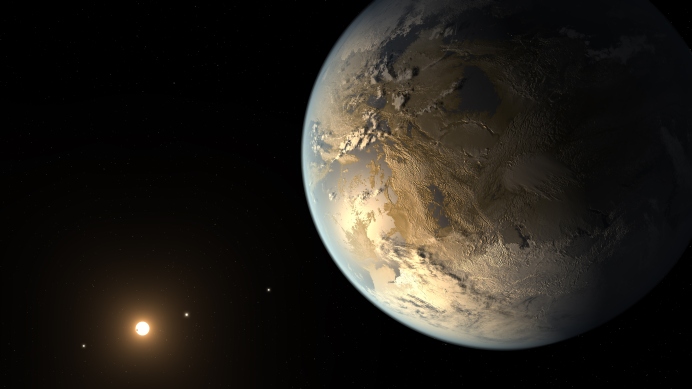Kepler 186f:
17.april.2014
First Earth-Size Planet Discovered That May Support Life
NASA scientists have just found an Earth-size planet outside of our solar system in the habitable region of its host star (red dwarf Kepler 186) that may possibly contain liquid water and the suitable environment for life. The discovery was made by NASA's Kepler spacecraft. This type of breakthrough of a rocky instead of a gaseous planet that could support and carry liquid water could be a big leap forward in the search for extraterrestrial life.
 The newly found planet, identified as Kepler-186f, was first discovered by NASA's Kepler space telescope and rotates a dim red dwarf about 490 light-years from us. While the red dwarf star is fainter than Earth's sun and the planet is about 10 percent bigger than Earth, the placement of the distant planet together with its size hints that Kepler-186f could have water on its surface.
The newly found planet, identified as Kepler-186f, was first discovered by NASA's Kepler space telescope and rotates a dim red dwarf about 490 light-years from us. While the red dwarf star is fainter than Earth's sun and the planet is about 10 percent bigger than Earth, the placement of the distant planet together with its size hints that Kepler-186f could have water on its surface.
"One of the things we've been looking for is maybe an Earth twin, which is an Earth-size planet in the habitable zone of a sun-like star. The Kepler-186f is an Earth-size planet in the habitable zone of a cooler star. So, while it's not an Earth twin, it is perhaps an Earth cousin." said Tom Barclay, Kepler scientist and co-author of the new exoplanet research team.
Essentially a habitable planet:
Scientists believe that Kepler-186f - the most distant and outermost of five planets determined to be orbiting the star Kepler-186 - orbits at a distance of 32.5 million miles (52.4 million kilometers), hypothetically inside of the habitable region of a red dwarf.
Small stars like Kepler-186 live much longer than bigger stars, giving more time for biological evolution to come about. This makes them likely areas to search for life
Earth's distance from the sun is about 93 million miles (150 million km (or 1 AU)), but the sun is bigger and brighter than the Kepler-186 star, so that the sun's habitable region starts farther away from the star compared to Kepler-186.
"This is the first definitive Earth-sized planet found in the habitable zone around another star," Elisa Quintana, of the SETI Institute and NASA's Ames Research Center and the head author of a new study describing the details, said in a report.

Other (exo)planets of a variety of sizes(mostly super-earths or mini-neptunes) have been found in the habitable zones of their stars. Anyhow, Kepler-186f is the first planet this close to Earth in size found orbiting in that possibly life-supporting space of an extrasolar system, based on exoplanet professionals.
Kepler-186f has a radius comparable to Earth-size, at 1.1 times the radius of Earth. Kepler-186f orbital period is 129.9 days
NASA's Kepler Mission uses a unique way named the transit method, which can detect possible planets as their orbits cross in front of their star, dimming the star's brightness.
• Disclaimer •

